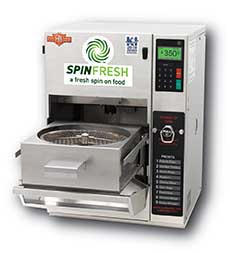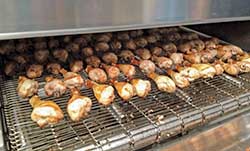Spins and Wrinkles on Frying Foods
PROCESSING
Frying foods in hot oil is a venerable process used at scales that range from the kitchen stove top to continuous industrial production of thousands of pounds per hour. The same characteristics that make frying popular, namely the texture and flavor it imparts, also contribute to its negative reputation as contributing to obesity and heart disease because of the fat that is inevitably added to fried foods and the formation of small quantities of by-products that may be carcinogens.
Advanced frying technologies often are directed at reducing the fat content of fried foods and controlling the color, flavor, and texture while retaining the desirable advantages of frying.
Frying is a high-rate heat transfer process in which water is removed, many chemical reactions occur, and foods are cooked. The temperatures involved kill pathogens. As discussed later, oils used in frying undergo chemical changes with time and contribute to the flavor and shelf life of fried foods. Frying can pose hazards to the kitchen or processing plant because frying oils are flammable and the evaporating water vapor can carry volatile organic compounds and entrained oil droplets that contribute to air pollution.
 Excess Oil Removal
Excess Oil Removal
SpinFry Inc., Woodridge, Ill. (www.spinfresh.com), holds a number of patents on a frying system in which centrifugal force is used to remove excess oil from the surface of foods. The foods are fried in batches by lowering a basket containing the food into a bath of hot oil, then raising the basket and spinning it above the bath. Some surface oil is removed and returned to the bath while the food continues to cook in the convective heat above the hot bath.
SpinFry has licensed its technology to Middleby Worldwide, Elgin, Ill. (www.middleby.com), a manufacturer of foodservice preparation equipment such as pizza ovens. In turn, Middleby is marketing a vented floor model under its Pitco brand and a countertop model by Perfect Fry Co.
Charlie Baggs Culinary Innovations, Chicago, Ill. (www.charliebaggsinc.com), evaluated the SpinFresh technology for frying breaded and battered chicken, according to Martina Buchholz, research food scientist. The company’s evaluators found that the fried chicken had less retained oil while having flavor, color, and texture equal to or better than chicken fried in conventional restaurant fryers.
Vacuum Frying
Another approach to reducing the fat content of fried foods is frying under vacuum. Many of the adverse characteristics of frying are directly related to high temperatures. Lowering the pressure lowers the temperature at which water boils and so permits using lower oil temperatures. Typically, for vegetable or fruit chips, such as potato, carrot, or apple, atmospheric frying occurs at 180°C. Under vacuum, the oil temperature can be 160°C.
In atmospheric frying, oil content of the fried food may be 30% to 40%. In vacuum frying, the oil content may be 20% to 25%. Another positive effect is the reduction in formation of acrylamide, a degradation product of proteins that is considered a possible carcinogen. Acrylamide formation is reduced at lower temperatures.
Vacuum frying also extends oil pot life. Frying oil degrades with time at elevated temperature due to a number of reactions, including oxidation, polymerization, and hydrolysis. All of these occur with reduced rates when temperature is reduced. Under vacuum, oxygen exposure is also reduced.
Oxidation of oil leads to rancidity or off-flavors, first in the oil and then in the fried food. Polyunsaturated oils are more vulnerable to oxidation than more saturated oils. On the other hand, saturated oils are considered more unhealthy due to their contribution to cholesterol and consequent circulatory and cardiac disease.
To increase thermal stability, polyunsaturated oils (multiple double bonds) are partially hydrogenated, but this then leads to formation of trans fatty acids, which also have been found to be unhealthy. Thus the ability to use polyunsaturated frying oils is one advantage of vacuum frying.
At present, it appears that vacuum frying is more popular in Asia than in the Western world. There are several suppliers of vacuum frying equipment in China and Vietnam. One marketer of vacuum fried fruit and vegetable chips, Danielle (www.daniellemarket.com), has them manufactured in Thailand. Danielle’s line includes some tropical fruits that might not be transported well, such as durian, mango, jackfruit, and others.
Vacuum frying is usually performed in batches, which puts it at a disadvantage to continuous atmospheric frying. Despite its advantages, it seems so far to be performed at a relatively small scale.
--- PAGE BREAK ---
Pressure Frying
At the opposite extreme from vacuum frying is pressure frying, another batch process. Pressure frying is performed in an enclosed vessel where the released steam increases pressure, raising the boiling point of water and thus the temperature at which food is cooked, to about 175°C to 184°C. The result is shortened cooking time and greater moisture retention compared to atmospheric frying. A major application is cooking meats such as chicken in foodservice applications.
Ordinarily, the higher temperature in pressure frying would contribute to shorter oil life, but since the atmosphere in the vessel is mostly steam, once the air is displaced, oxidation, at least, is reduced.
Frying oils interact with the foods, such as salt-containing coatings, to hydrolyze into mono- and diglycerides and, eventually, free fatty acids and glycerol. Glycerol can degrade to acrolein, a relatively unpleasant-smelling chemical. Hot oils can form carbon deposits on surfaces, which can be difficult to clean.
An interesting dilemma in frying is that the more oil removed with the product, the fresher, on average, the oil in the fryer, because fresh oil is added to maintain a constant level. When steps are taken to reduce oil pickup, the average age of oil increases and there is more risk of rancidity and degradation. In the extreme, oil that has aged excessively must be discarded, creating a waste issue and downtime.
Interestingly, the waste issue is being somewhat resolved by the demand to convert waste oil into biodiesel fuel. For the biodiesel manufacturer, waste oil is inexpensive compared to virgin oil; it might even have a negative cost since the restaurant or food plant would otherwise pay to dispose of it. On the other hand, its quality for biodiesel production is variable, as most waste products are.
Conventional Frying
Salty snacks, partially fried French fries, and various forms of chicken probably account for a large fraction of commercially fried products. These typically use large, continuous atmospheric fryers with conveyor chains to move products through the hot oil. Doughnuts and other fried pastries are another large category. Fryers for each application are tailored to the time and temperature required. Heavier products obviously require longer immersion times. Products that float, such as doughnuts, need to be turned over midway to get even treatment.
Oil may be heated directly by electricity or burning fuel, or, more commonly, by external heat exchangers that may be heated by high pressure steam. Recirculating oil is usually filtered to remove food particles that become burnt and help catalyze degradation. Product rates for conventional potato chips approach 5,000 lb/hr, requiring feed rates of about 25,000 lb/hr.
Potato chips are valued for uniform light color, so fried chips are scanned by optical sorters, which can detect and reject dark chips for re-examination. The exhaust from fryers can be used to preheat oil or water as an energy recovery scheme. Doing so may also reduce entrained oil droplets and reduce oil losses from that mechanism.
Conventional frying can be supplemented by other energy sources, such as microwave energy. For doughnut frying, it was found that microwave energy directed at the floating doughnuts could shorten frying time and reduce oil retention.
Oils for Frying
Most vegetable oils can be used for frying, but some are more stable under heat than others. The trend is to use less saturated oils where possible in spite of their potentially lower use lives. As mentioned, enough oil is removed with product that the average life in the fryer can be relatively small.
Another approach has been to develop frying oils that are indigestible. One example is sugar polyester, known commercially as Olestra. Unfortunately, some people experience gastric distress after consuming products fried in Olestra, so it has not really been successful. From an engineering standpoint, Olestra was challenging because it has a high melting point and so was difficult to transport until it was melted and then had peculiar crystallization behavior.
 Compact Cooking
Compact Cooking
While not for frying, Unitherm, Bristow, Okla. (www.unithermfoodsystems.com), offers an interesting option for cooking and baking in compact spiral ovens. The company’s mini system is about 8 x 8 x 8 ft and provides 180 ft of belt, allowing cooking/baking of about 1,500 lb/hr (unspecified product and temperature treatment). The micro system is 5 x 7 x 7 ft and, with 60 ft of belt, presumably could process about 500 lb/hr.
Spiral systems are commonly used in the cooling, freezing, and proofing of baked goods, but they are less commonly used for heating and baking. They seem especially promising for baking applications in developing markets where flexibility is valued.
 J. Peter Clark, Ph.D., CFS,
J. Peter Clark, Ph.D., CFS,
Contributing Editor,
Consultant to the Process Industries, Oak Park, Ill.
[email protected]
